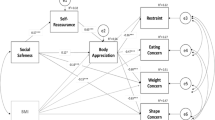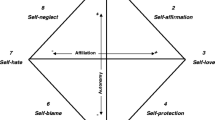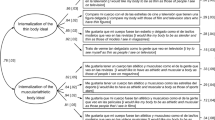Abstract
OBJECTIVE: We tested the hypothesis that a protective self-presentation style (Lennox and Wolfe, 1984) is associated with eating pathology and anorexia nervosa (AN) and that this association is mediated by sociocultural attitudes towards appearance emphasizing the thin ideal. METHOD: We compared the protective-presentation style of women with AN (N=17), partially recovered women (N=110), fully recovered women (N=73), and female controls (N=374). RESULTS: Ill women had a more protective self-presentation style than partially or fully recovered women, who in turn had a more protective self-presentation style than controls. Sociocultural attitudes towards appearance fully mediated the association between protective self-presentation and disordered eating. CONCLUSIONS: Protective self-presentation may therefore be a risk factor for AN and/or a prognostic factor. Implications for therapy and prevention are discussed.
Similar content being viewed by others
References
Arkin R.M.: Self-presentation styles. In: Tedeschi J.T. (Ed.). Impression management theory and social psychological research. New York, Academic Press, 1981.
Tetlock P.E., Manstead A.S.R.: Impression management versus intrapsychic explanations in social psychology: A useful dichotomy? Psychol. Rev., 92, 59–77, 1985.
Lennox, R.D., Wolfe R.N.: Revision of the Self-Monitoring Scale. J. Pers. Soc. Psychol., 46, 1349–1364, 1984.
Goffman E.: Interaction ritual. Chicago, Aldine, 1967.
Hogan R.: A socioanalytic theory of personality. In: Page M.M. (Ed.). Nebraska symposium on motivation, 1982: Personality — current theory and research. Lincoln, NE, University of Nebraska Press, 1982, pp. 55–89.
Snyder M.: Self-monitoring of expressive behavior. J. Pers. Soc. Psychol., 30, 526–537., 1974.
Anderson L.: Test-retest reliability of the Revised Self-Monitoring Scale over a two-year period. Psychol. Rep., 68, 1057–1058, 1991.
Miller M.L., Omens R.S., Delvadia R.: Dimensions of social competence: personality and coping style correlates. Pers. Individ. Dif., 12, 955–964, 1991.
Ellis R.: Self-monitoring and leadership emergence in groups. Pers. Soc. Psychol. Bull., 14, 681–693, 1988.
Spiro R.L., Weitz B.A.: Adaptive selling: conceptualization, measurement, and nomological validity. Journal of Marketing Research, 27, 61–69, 1990.
Wolfe R.N., Grosch J.W.: Personality correlates of confidence in one’s decisions. J. Pers., 58, 515–534, 1990.
Anderson L.R.: Self-monitoring and performance in nontraditional occupations. Basic Appl. Soc. Psychol., 8, 85–96, 1987.
Celuch K., Slama M.: “Getting Along” and “Getting ahead” as motives for self-presentation: their impact on advertising effectiveness. J. Appl. Soc. Psychol., 25, 1700–1713, 1995.
Celuch K., Slama M., Schaffenacker S.: Concern for appropriateness and ad context effects. Psychology and Marketing, 14, 19–28, 1997.
Bearden W.O., Netemeyer R., Teel J.: Measurement of consumer susceptibility to interpersonal influence. J. Consum. Res., 16, 473–481, 1989.
Netemeyer R., Bearden W., Teel J.: Consumer susceptibility to interpersonal influence and attributional sensitivity. Psychology and Marketing, 9, 379–394, 1992.
Bearden W., Rose R.: Attention to social comparison information: an individual difference factor affecting consumer conformity. J. Consum. Res., 16, 473–481, 1990.
Johnson M.A.: Concern for Appropriateness scale and behavioral conformity. J. Pers. Assess., 53, 567–574, 1989.
Bruch H.: Conversations with anorexics. New York, Basic, 1988, p. 22.
Claude-Pierre P.: The secret language of eating disorders. Sydney, Bantam, 1997, p. 169.
Bachar E.: The contributions of self psychology to the treatment of anorexia and bulimia. Am. J. Psychother., 52, 147–167, 1998.
Goodsit A.: Eating disorders: A self psychological perspective. In: Garner D., Garfinkel P.E. (Eds.). Handbook of psychotherapy for eating disorders. New York, Guilford Press, 1997, pp. 55–82.
Silverstone P.H.: Is chronic low self-esteem the cause of eating disorders? Med. Hypotheses, 39, 311–315, 1992.
Halmi K.A., Sunday S.R., Strober M., Kaplan A., Woodside D.B., Fichter M., Treasure J., Berrettini W. H., Kaye W.H.: Perfectionism in anorexia nervosa: Variation by clinical subtype, obsessionality, and pathological eating behavior. Am. J. Psychiatry, 157, 1799–1805, 2000.
Bjorck C., Clinton D., Sohlberg S., Hallstrom T., Norring C.: Interpersonal profiles in eating disorders: Ratings of SASB self-image. Psychol. Psychother., 76, 337–349, 2003.
Regan P.C.: Sexual outcasts: The perceived impact of body weight and gender on sexuality. J. Appl. Soc. Psychol., 26, 1803–1815, 1996.
Wooley S.C., Wooley O.W.: Eating disorders, obesity and anorexia. In: Brodsky A., Hare-Mustin R. (Eds.). Women and psychotherapy. New York, Guilford Press, 1980, pp. 135–159.
Bulik C.M., Sullivan P.F., Fear J.L., Pickering A.: The outcome of anorexia nervosa: eating attitudes, personality, and parental bonding. Int. J. Eat. Disord., 28, 139–147, 2000.
Bloks H., Wijbrand Hoek H., Callewaert I., van Furth, E.: Stability of personality traits in patients who received intensive treatment for a severe eating disorder. J. Nerv. Ment. Dis., 192, 129–138, 2004.
Kennedy S.H., McVey G., Katz R.: Personality disorders in anorexia nervosa and bulimia nervosa. J. Psychiatr. Res., 24, 259–269, 1990.
Ward A., Brown N., Lightman S., Campbell I.C., Treasure J.: Neuroendocrine, appetitive and behavioral responses to d-fenfluramine in women recovered from anorexia nervosa. Br. J. Psychiatry, 172, 351–358, 1998.
Wiseman C.V., Gray J.J., Mosimann J.E., Ahrens A.H.: Cultural expectations of thinness in women: An update. Int. J. Eat. Disord., 11, 85–89, 1992.
McCarthy M.: The thin ideal, depression and eating disorders in women. Behav. Res. Ther., 28, 205–215, 1990.
First M.B., Spitzer R.L., Gibbon M., Williams J.B.W.: Structured Clinical Interview for DSM-IV axis I Disorders (SCID), Clinical Version: Administration Booklet. Washington, DC, American Psychiatric Press, 1996.
Williams J.B.W.: The Structured Clinical Interview for DSM-III-R (SCID): multisite test-retest reliability. Arch. Gen. Psychiatry, 49, 630–636, 1992.
Garner D., Olmsted M.P., Polivy J., Garfinkel P.E.: Comparison between weight-preoccupied women and anorexia nervosa. Psychosom. Med., 46, 255–266, 1984.
Cutler B.L., Wolfe R.N.: Construct validity of the Concern for Appropriateness scale. J. Pers. Assess., 49, 318–323, 1985.
O’Cass A.: A psychometric evaluation of a revised version of the Lennox and Wolfe Revised Self-Monitoring Scale. Psychology and Marketing, 17, 379–419, 2000.
Bearden W.O., Shuptrine F.K., Teel J.T.: Self-monitoring and reactions to image appeals and claims about product quality. Adv. Consum. Res., 16, 703–710, 1989.
Shruptine K., Bearden W., Teel J.: An analysis of the reliability and validity of the Lennox and Wolfe revised self-monitoring scale. J. Pers. Assess., 54, 512–522, 1990.
Garner D.M., Olmsted M.P., Bohr Y., Garfinkel P.E.: The Eating Attitudes Test: psychometric features and clinical correlates. Psychol. Med., 12, 871–878, 1982.
Garner D.M., Garfinkel P.E.: The Eating Attitudes Test: an index of the symptoms of anorexia nervosa. Psychol. Med., 9, 273–279, 1979.
Heinberg L.J., Thompson J.K., Stormer S.: Development and validation of the Sociocultural Attitudes Towards Appearance Questionnaire. Int. J. Eat. Disord., 17, 81–89, 1995.
Smolak L., Levine M.P., Thompson J.K.: The use of the Sociocultural Attitudes Towards Appearance Questionnaire with middle school boys and girls. Int. J. Eat. Disord., 29, 216–223, 2001.
Griffiths R.A., Beumont P.J.V., Russell J., Schotte D., Thornton C., Touyz S.W., Varano P.: Sociocultural attitudes towards appearance in dieting and nondieting disordered subjects. Int. J. Eat. Disord., 17, 81–89, 1999.
Cusumano D.L., Thompson J.K.: Body image and body shape ideals in magazines: exposure, awareness, and internalization. Sex Roles, 37, 701–721, 1997.
Koslowsky M., Scheinberg Z., Bleich A., Mark M., Apter A., Danon Y., Solomon Z.: The factor structure and criterion validity of the short form of the Eating Attitudes Test. J. Pers. Assess., 58, 27–35, 1992.
Kraemer H.C., Stice E., Kazdin A., Offord D., Kupfer D.: How do risk factors work together? Mediators, moderators, and independent, overlapping, and proxy risk factors. Am. J. Psychiatry, 158, 848–856, 2001.
Baron R.M., Kenny D.A.: The moderator-mediator variable distinction in social psychological research: Conceptual, strategic, and statistical considerations. J. Pers. Soc. Psychol., 51, 1173–1182, 1986.
Collins L.M., Graham J.W., Flaherty B.P.: An alternative framework for defining mediation. Behav. Res., 33, 295–312, 1998.
Kenny D.A., Kashy D.A., Bolger N.: Data analysis in social psychology. In: Gilbert D., Fiske S.T., Lindzey G. (Eds.). Handbook of social psychology, 4th edition. New York, McGraw-Hill, 1998, vol. 1, pp. 233–265.
MacKinnon D.P., Warsi G., Dwyer J.H.: A simulation study of mediated effect measures. Multivariate Behav. Res., 30, 41–62, 1995.
Sobel M.E.: Effect analysis and causation in linear structural equation models. Psychometrika, 21, 405–410, 1990.
Sobel M.E.: Some new results on indirect effects and their standard errors in covariance structure models. In: Tuma N. (Ed.). Sociological methodology. Washington, DC, American Sociological Association, 1986, pp. 159–186.
Myers P.N., Biocca F.A.: The elastic body image: The effect of television advertising and programming on body image distortions in young women. J. Commun., 42, 108–132, 1992.
Stice E., Schupak-Neuberg E., Shaw H.E., Stein R.I.: Relation of media exposure to eating disorder symptomatology: An examination of mediating mechanisms. J. Abnorm. Psychol., 103, 836–840, 1994.
Stormer S., Thompson J.K.: Explanations of body image disturbance: a test of maturational status, negative verbal commentary, social comparison, and sociocultural hypotheses. Int. J. Eat. Disord., 19, 193–202, 1996.
Schlenker B.R.: Impression management: The self-concept, social identity and interpersonal relations. Belmont, CA, Brooks/Cole, 1982.
Ogden J., Mundray K.: The effect of the media on body satisfaction: the role of gender and size. Eur. Eat. Disord. Rev., 4, 171–182, 1996.
Harrison K., Cantor J.: The relationship between media consumption and eating disorders. J. Commun., 47, 40–68, 1997.
Thomsen S.R., Weber M.M., Brown L.B.: The relationship between reading beauty and fashion magazines and the use of pathogenic dieting methods among adolescent females. Adolescence, 37, 1–18, 2002.
Botta R.A: Television images and adolescent girls’ body image disturbance. J. Commun., Spring, 22-41, 1999.
Irving L.M.: Mirror images: effects of the standard of beauty on the self- and body-esteem of women exhibiting varying levels of bulimic symptoms. J. Soc. Clin. Psychol., 9, 230–242, 1990.
Posavac H.D., Posavac S.S., Posavac E.J.: Exposure to media images of female attractiveness and concern with body weight among young women. Sex Roles, 38, 187–201, 1998.
Heinberg L.: Theories of body image disturbance: Perceptual, developmental, and sociocultural factors. In: Thompson J. K. (Ed.). Body image, eating disorders, and obesity: an integrative guide for assessment and treatment. Washington, DC, American Psychological Association, 1996, pp. 27–48.
Smolak L., Levine M., Schermer F.: Parental input and weight concerns among elementary school children. Int. J. Eat. Disord., 25, 263–271, 1999.
Thompson J.K., Smolak L.: Body image, eating disorders and obesity in youth: assessment, prevention, and treatment. Washington, DC, American Psychological Association, 2001.
van den Berg P., Wertheim E.H., Thompson J.K., Paxton S.J.: Development of body image, eating disturbance, and general psychological functioning in adolescent females: a replication using covariance structure modeling in an Australian sample. Int. J. Eat. Disord., 32, 46–51, 2002.
Wade T.D., Lowes J.: Variables associated with disturbed eating habits and overvalued ideas about the personal implications of body shape and weight in a female adolescent population. Int. J. Eat. Disord., 32, 39–45, 2002.
Thompson J.K., Coovert M., Richards K., Johnson S., Cattarin J.: Development of body image, eating disturbance, and general psychological functioning in female adolescents: covariance structure modeling and longitudinal investigations. Int. J. Eat. Disord., 18, 221–236, 1995.
Cattarin J., Thompson J.K.: A three-year longditudinal study of body image, eating disturbance, and general psychological functioning in adolescent females. Eat. Disord., 2, 114–125, 1994.
Crowther J.H., Kichler J.C., Sherwood N., Kuhnert M.E.: The role of familial factors in bulimia nervosa. Eat. Disord., 10 141–151, 2002.
Fairburn C.G., Welsh S., Doll H.A., Davies B.A., LM.E.: Risk factors for bulimia nervosa: a community-based case-control study. Arch. Gen. Psychiatry, 54, 509–517, 1997.
Mehler P.S., Anderson A.E.: Eating disorders: medical care and complications. Baltimore, Maryland, John Hopkins University Press, 1999.
Moreno A.B., Thelen M.H.: A preliminary prevention program for eating disorders in a junior high school population. J. Youth Adolesc., 22, 109–124, 1993.
Hermes S.F., Keel P.K.: The influence of puberty and ethnicity on awareness and internalization of the thin ideal. Int. J. Eat. Disord., 33, 465–467, 2003.
Wertheim E.H., Paxton S.J., Schultz H.K., Muir S.L.: Why do adolescent girls watch their weight? An interview study examining sociocultural pressures to be thin. J. Psychol. Res., 42: 345–355, 1997.
Arnett J.J., Larson R., Offer D.: Beyond effects: adolescents as active media users. J. Youth Adolesc., 24, 511–518, 1995.
Heaven P.C.L.: Contemporary adolescence: a social psychological approach. Melbourne, Australia, Macmillan, 1991.
Paxton S.J.: Prevention implications of peer influences on body image dissatisfaction and disturbed eating in adolescent girls. Eat. Disord., 4, 334–347, 1996.
Levine M., Smolak L., Hayden H.: Normative developmental challenges and dieting and eating disturbances in middle school girls. Int. J. Eat. Disord., 15, 11–20, 1994.
Striegel-Moore R.H., Kearney-Cooke A.: Exploring parents’ attitudes and behaviors about their children’s physical appearance. Int. J. Eat. Disord., 15, 377–385, 1994.
Festinger L.: A theory of social comparison processes. Hum. Relat., 7, 117–140, 1954.
Bandura A.: Social Learning Theory. New York, General Learning Press, 1977.
Gudykunst W.B., Gao G., Franklyn-Stokes A.: Selfmonitoring and concern for social appropriateness in China and England. In: Pandey J., Sinha D., Bhawuk D.P.S. (Eds.). Asian contributions to cross-cultural psychology. New Delhi, Sage Publications, 1996.
Shumaker J.F., Barraclough R.: Protective self-presentation in Malaysian and Australian individuals. J. Cross Cult. Psychol., 20, 54–63, 1989.
Bachner-Melman R., Zohar A.H., Elizur Y., Nemanov L., Gritsenko I., Konis D., Ebstein R.P.: Association between a vasopressin receptor AVPRIA promoter region microsatellite and eating behavior measured by a self-report questionnaire (Eating Attitudes Test) in a family-based study of a non-clinical population. Int. J. Eat. Disord., 36, 451–460, 2004.
Bachner-Melman R., Zohar A.H., Bacon-Shnoor N., Elizur Y., Nemanov L., Gritsenko I., Ebstein R.P.: Link between vasopressin receptor AVPR1A promoter region microsatellites and measures of social behavior in humans. Journal of Individual Differences, 26, 2–10, 2005.
Piran N.: Prevention of eating disorders: Directions for future research. Psychopharmacol. Bull., 33, 419–423, 1997.
Braun D.L., Sunday S.R., Halmi K.A.: Psychiatric comorbidity in patients with eating disorders. Psychol. Med., 24, 859–867, 1994.
Hoek H.W., van Hoeken D.: Review of the prevalence and incidence of eating disorders. Int. J. Eat. Disord., 34, 383–396, 2003.
Pasberg A., Wang A.: Epidemiology of anorexia nervosa and bulimia nervosa in Bornholm Country, Denmark, 1970–1989. Acta Psychiatr. Scand., 90, 259–265, 1994.
Doll H.A., Fairburn C.G.: Heightened accuracy of selfreported weight in bulimia nervosa: a useful cognitive distortion. Int. J. Eat. Disord., 24, 267–273, 1998.
McCabe R.E., McFarlane T., Polivy J., Olmsted M.P.: Eating disorders, dieting, and the accuracy of selfreported weight. Int. J. Eat. Disord., 29, 59–64, 2001.
Rowland M.: Self-reported weight and height. Am. J. Clin. Nutr., 52, 1125–1133, 1990.
Fortenberry J.D.: Reliability of adolescents’ reports of height and weight. J. Adolesc. Health, 13, 114–117, 1992.
Cash T.F., Counts B., Hangen J., Huffine C.E.: How much do you weigh? Determinants of validity of self-reported body weight. Percept. Mot. Skills, 68, 248–250, 1989.
Pearson J., Goldklang D., Striegel-Moore R.H. Prevention of eating disorders: challenges and opportunities. Int. J. Eat. Disord., 31, 233–239, 2001.
Author information
Authors and Affiliations
Corresponding author
Rights and permissions
About this article
Cite this article
Bachner-Melman, R., Zohar, A.H., Elizur, Y. et al. Protective self-presentation style: Association with disordered eating and anorexia nervosa mediated by sociocultural attitudes towards appearance. Eat Weight Disord 14, 1–12 (2009). https://doi.org/10.1007/BF03327789
Received:
Accepted:
Published:
Issue Date:
DOI: https://doi.org/10.1007/BF03327789




